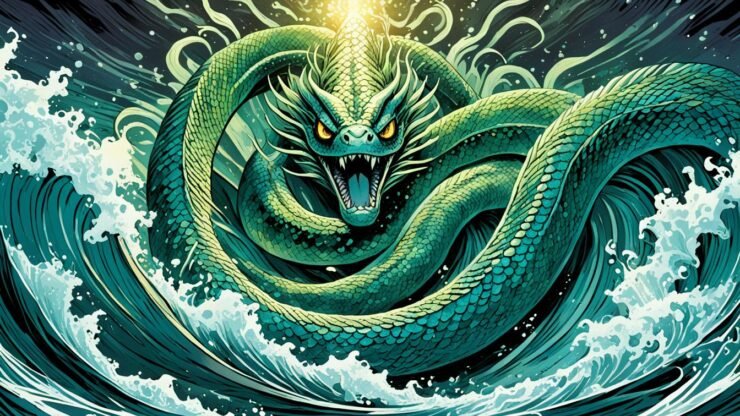Deep within the crystal clear waters near Negros island lies Nanreben, the sea serpent of Philippine folklore. For ages, stories of this mystical creature have delighted listeners. They’ve been shared from mouth to ear, adding mystery and wonder with each telling.
A tale recounts Juan, a local fisherman, heading out on a clear day. While fishing, he saw the sea move strangely. Looking closer, he spotted Nanreben. This legendary sea serpent, with its shiny scales and wings, astounded him. This brief meeting forever changed Juan’s perspective on the mythical beings in Philippine mythology.
This story is just one in the vast collection of Philippine folklore. It highlights the durable influence of indigenous myths and legends. The Philippines is home to abundant extraordinary tales. They bridge the natural and the supernatural, creating a world where mystery and beauty meet.
Key Takeaways
- Philippine mythology is a rich tapestry of stories and epics that incorporate elements from diverse cultural influences.
- Nanreben, the sea serpent of Negros, is a captivating mythical creature within the broader landscape of Philippine folklore.
- The narratives surrounding Nanreben reflect the deep-rooted connections between the natural world and the spiritual realm in Philippine indigenous cosmologies.
- Despite the challenges of cultural erosion, there is a resurgence of interest in preserving and promoting the country’s mythological heritage.
- Exploring the myths and legends of the Philippines offers valuable insights into the nation’s vibrant and multifaceted cultural identity.
Introduction to Philippine Mythology
Philippine mythology is about explaining the world. It tells stories of heroes, gods, and mythological creatures. Most of these stories were shared by talking, and some were written down. People used to call these beliefs “Anitism” or “Anito”, which means “ancestral religion”.
Even today, many groups keep their own indigenous religions alive. This is despite other religions from afar, which came through conversions and mixing with other cultures. The many stories in Philippine mythology show its varied roots and strong beliefs across the islands.
Sources of Philippine Mythology
Philippine mythology comes from two main places: stories passed down by talking and those written down. Folk literature, or what we call oral literature, includes tales told and retold between families and friends. Because these stories were shared by talking, they often change a bit over time or as new ones get added. Despite many efforts, much of this oral lore hasn’t been officially written or recorded yet.
Oral (Folk) Literature
Folk literature is key to understanding Philippine myth. These stories were shared across the generations by just talking about them. This kind of storytelling has kept the country’s cultural heart strongly alive. It’s a vivid part of many groups’ traditions. The stories change and find new meaning as they move through time.
Written Literature
Books and other written works are important for keeping Philippine myths alive, too. They include ancient texts and more modern stuff. Some old examples are books from about 1589 made by people like Juan de Plasencia. Others, like the ones from the early 17th century by Miguel de Loarca and Pedro Chirino, keep adding to the written history. Universities and book publishers also put out materials about Anitism and other mythologies. They’ve been doing this for hundreds of years, helping to make sure the myths are never forgotten.
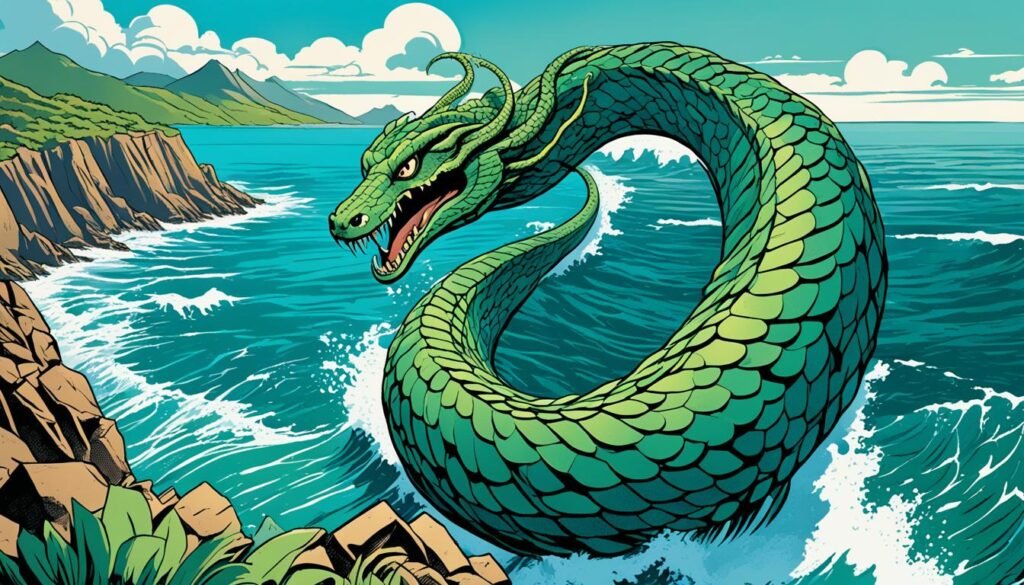
History of Philippine Mythology
The indigenous religions of the Philippines grew through different phases and trade routes. It’s believed that Austronesians first arrived through the “Out-of-Taiwan model”. They brought along complex animist beliefs and shamanism. This also included ancestor worship, totemism, and the art of tattooing.
Hindu and Buddhist Influences
Between 200 and 300 CE, parts of the Philippines saw Hindu mythologies arrive. This happened through trade and migration, introducing Indianized traditions. It also brought the concept of good and bad demons. After 900 CE, the influence of China introduced Sinified beliefs and Buddhist myths to the Philippines.
Islamic Influences
By 1300 CE, Muslim traders reached the southern Philippines. They carried Islamic mythologies and beliefs with them.
Spanish Colonial Period
In the 16th century, the Philippines welcomed the Spanish from Latin America. This introduced Christian mythologies and belief systems. It marked the beginning of a three-century-long struggle against the indigenous religions of the islands.
Regional Variations in Philippine Mythology
The Philippines is home to many ethnic groups. They have rich stories and beliefs that show how cultures have mixed over time. For example, the Bicolano and Visayan peoples share myths about how the world began. They also have stories about gods and goddesses like Mayari and Bulan, and creatures like Bakunawa. But, each group tells these stories in their own way.
The many myths in the Philippines make its culture colorful and diverse. Each group tells different stories. These stories are influenced by their own history, beliefs, and the world around them. It shows how cultures have changed and grown over time.
| Region | Mythological Beings |
|---|---|
| Visayas | Agalon Hayopan, Anananggal |
| Waray | Abat, Agta, Amalanhig |
| Bicol | Anananggal, Anduduno |
This table shows that each region in the Philippines has its own unique myths. The Visayas, Waray, and Bicol regions, for example, have tales of special creatures. These creatures are important in their cultures and show their beliefs.
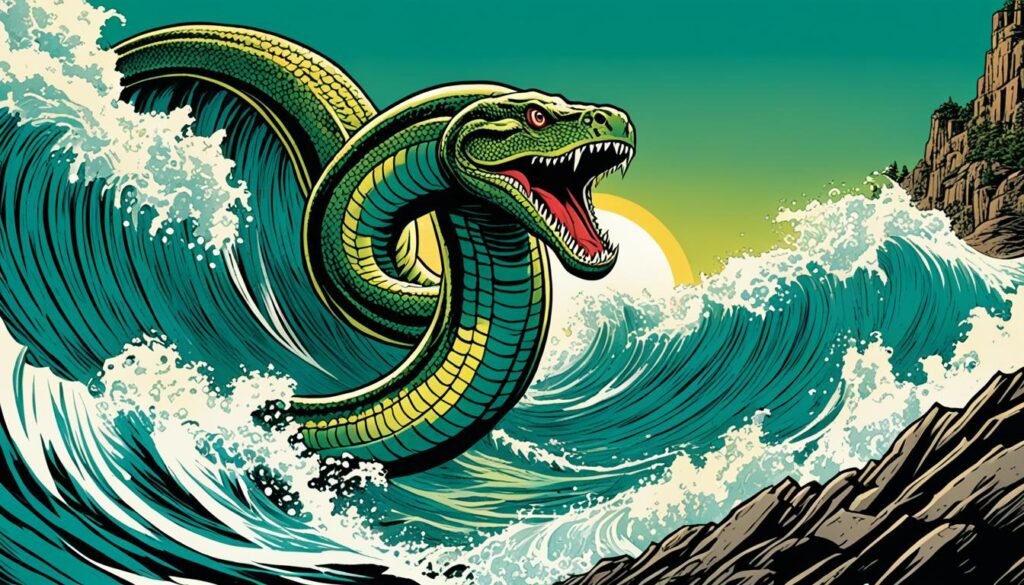
Cosmogony and Creation Myths
Philippine mythology tells many creation myths and stories. They aim to explain how the world and universe began. Deities like the top god Bathala, Lakapati who is part male and female, and Diyan Masalanta, the love goddess, play big roles.
These creation myths talk about change, the first man and woman, and where stars and nature came from.
Philippine mythology is full of different origin stories and cosmogony. It shows a mix of cultural and religious beliefs. These come from early Austronesian and later Hindu, Buddhist, Islamic, and Christian stories.
This mix makes a unique and rich view of the world’s creation. It shows the connection between nature and the spirit across the Philippines.
Many ethnic groups share moon and serpent god stories. This connects their myths, showing a united cultural past. As we learn more about these ancient tales, we see the deep and inspiring beliefs of the Philippines’ people.
The Concept of Realms
In Philippine mythology, there are various realms like heaven (kaluwalhatian, kalangitan, kamurawayan) and hell (kasamaan, sulad). There is also the concept of the human soul (kaluluwa, kaulolan, makatu, ginokud). These realms come from a mix of Hindu, Buddhist, and Christian beliefs. They’ve combined with the Philippines’ traditional myths across time.
Philippine cosmology has many realms. Each has its own life and rules. The kaluwalhatian or kalangitan is seen as a divine place. It’s where Bathala (the highest god) and other heavenly beings are.
Conversely, the kasamaan or sulad is linked to the afterlife. It’s where evil souls are sent.
The idea of the human soul, known as kaluluwa, kaulolan, makatu, or ginokud, is crucial. These beliefs about the soul’s existence and journey mix local and foreign ideas. These have developed over many years.
| Realm | Description |
|---|---|
| Kaluwalhatian, Kalangitan, Kamurawayan | The realm of the divine, where the supreme deity Bathala and other celestial beings reside. |
| Kasamaan, Sulad | The realm associated with the afterlife and the realm of the dead, where the souls of the wicked are said to be condemned. |
| Kaluluwa, Kaulolan, Makatu, Ginokud | The concept of the human soul, and its nature, journey, and relationship with the divine realms. |
The detailed cosmology in Philippine myths shows their deep spiritual beliefs. It reflects their unique mix of local and foreign religious ideas over time.
Deities in Philippine Mythology
Philippine mythology is full of different deities, called anito or diwata by some tribes. These deities have many jobs. They can control nature, watch over people, or help in between humans and the spirits. The way they do these things shows how the old Filipino beliefs mixed with ideas from Hinduism, Buddhism, and Islam over time.
Take the diwata, for example. They’re like the gods and goddesses next in line after the top god. They look after natural places like forests and mountains. Then there are the anito, believed to be spirits of the ancestors or deities. They help make the connection between the living and the spirit world possible. This mix of many different deities shows how Philippine mythology kept growing to include new stories and ideas over the years.
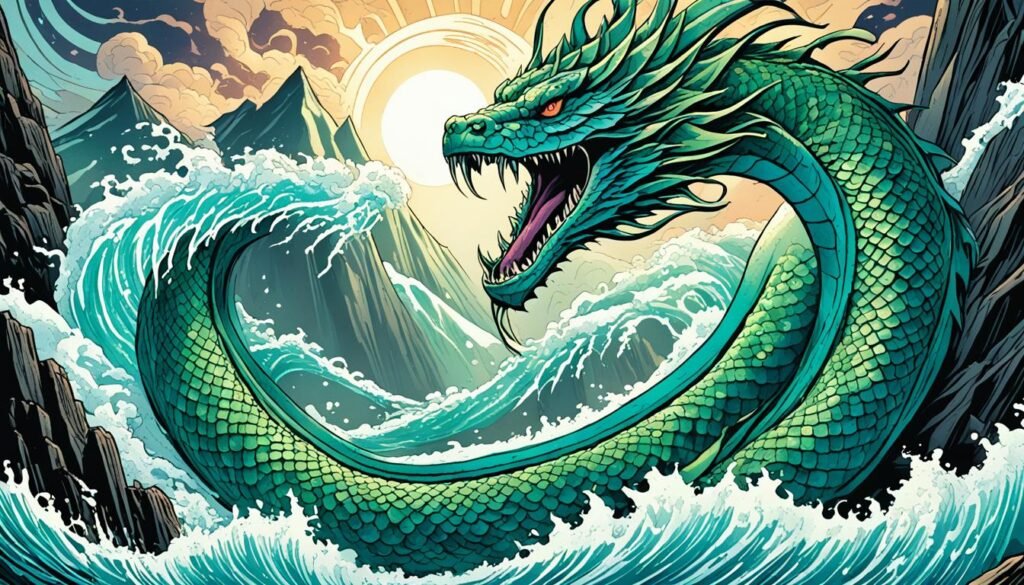
The polytheistic part of Philippine mythology also includes gods for certain natural things. For instance, there’s Diyan Masalanta, the love goddess, and Bathala, often seen as the chief god. This collection of deities and how they all relate is key to local spiritual beliefs. It helps people understand their connection to the world around them.
Heroes and Human Figures
Philippine mythology has a wealth of heroic and human stories. Often, these are passed down through epic tales and folklore. The heroes here may have amazing powers, hold key cultural values, or stand for resilience and defiance. These stories are a big part of the Philippines’ deep literary heritage.
Whether it’s about incredible heroes or the struggles of everyday people, the country’s folklore is packed with stories that show the power of the human spirit. This folklore isn’t just for fun; it keeps alive the important cultural lessons and the ability of Filipinos to overcome hard times.
The stories can range from witty tricksters to epic heroes. They all keep drawing people in, from the Philippines and elsewhere. These stories and myths show off the varied cultural background of the Philippines. They also show how storytelling can bring us together, by showing our connected human experiences.
| Legendary Philippine Heroes | Defining Characteristics |
|---|---|
| Lam-ang | A hero from the Ilocano epic who has super powers. He gets revenge for his father’s death. |
| Maragtas | He’s a leader among the Visayans. He talks with Datus to form the Kedatuan of Madja-as. |
| Malakas and Maganda | These two are the first Filipinos, made by Bathala. They start the Filipino race. |
| Bernardo Carpio | A notable hero from Luzon. He’s thought to have great strength and fights against wrongs. |
Monsters, Familiars, and Mythological Creatures
Philippine mythology is full of monsters, familiars, and mythological creatures. Each one has unique stories and traits. The Nanreben, from Negros, is a serpent-like creature that catches the eye. There’s also the Bakunawa, a big sea serpent linked to eclipses, and the Tambanokano, known for “eating” the moon. These beings show the vast creativity and cultural mix in the Philippines.
Nanreben
The Nanreben is from Negros and it’s known for being serpentine. It plays a big role in Philippine myths. Stories about the Nanreben connect to local cultures and beliefs. It’s often shown as a huge snake with special features like whiskers and wings. The Nanreben’s meaning shows the strong link between nature and spirituality in Philippine traditions.
Bakunawa
The Bakunawa is a giant sea serpent that stands out in Filipino myths. People thought it caused eclipses. This creature symbolizes the ocean’s power and mystery in the folklore. Beliefs about the Bakunawa reflect respect for nature and the connection between earth and spirit in Philippine culture.
Tambanokano
The Tambanokano is a moon-swallowing monster seen differently by various ethnic groups. It’s linked with lunar eclipses and moon phases. This links it to the cycle of the heavens in Filipino thought. The many faces of the Tambanokano show the depth and variety of Filipino myths.
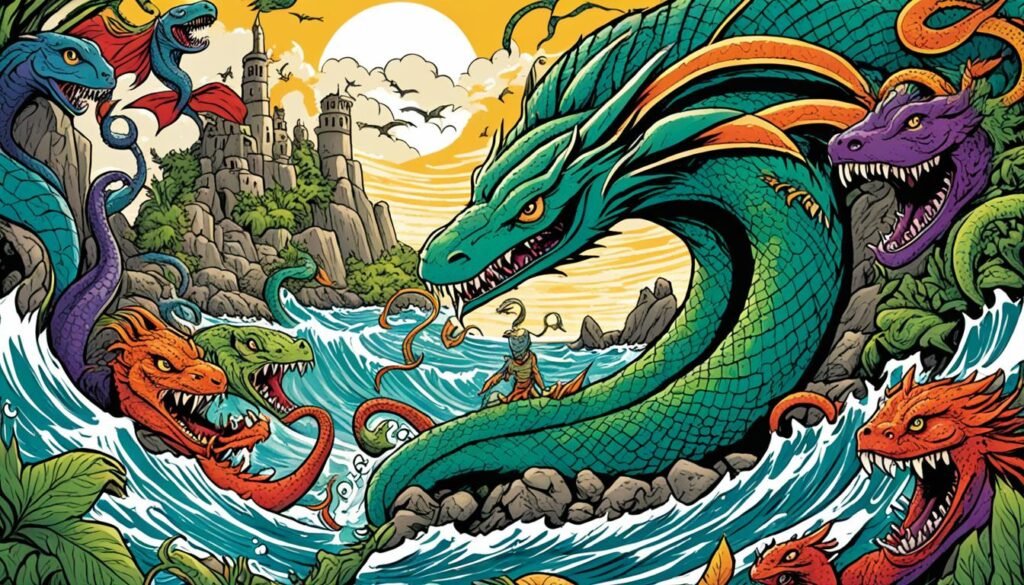
Mythological Races
The Philippines has a wide array of mythological races. These range from humanoid creatures to supernatural beings. Each group has its own physical looks, ways of life, and roles in stories or beliefs. This variety shows how rich and adaptable Philippine mythology is across time.
In Philippine stories, you’ll find Duwende, small humanoid entities fond of the outdoors. Then there are the Diwata, powerful beings of the forest. They have different powers and jobs. Don’t forget the Kapre, a huge cigar-smoking figure, or the Tikbalang with its horse head. These characters stand out in the diverse mix of mythological races.
There’s also the Aswang, known for changing shape and eating human flesh. And the Manananggal, which can fly after separating its upper body. The Sarimanok, a colorful bird, and the Siyokoy, a sea creature like a mermaid, show how varied supernatural beings are in Philippine myths.
| Mythological Race | Characteristics | Role in Mythology |
|---|---|---|
| Duwende | Diminutive humanoid creatures | Associated with the natural world |
| Diwata | Supernatural forest-dwelling entities | Possess a range of powers and responsibilities |
| Kapre | Towering, cigar-smoking giant | Prominent figure in Philippine folklore |
| Tikbalang | Horse-headed humanoid | Widely recognized in Philippine mythology |
| Aswang | Shape-shifting creature that consumes human flesh | Feared and infamous in Philippine folklore |
| Manananggal | Being that can detach its upper body and sprout bat-like wings | Represents the duality of human and supernatural nature |
| Sarimanok | Mythical bird with vibrant plumage | Symbolizes good luck and prosperity in Philippine culture |
| Siyokoy | Mermaid-like sea creature | Reflects the rich maritime traditions of the Philippines |
The range of mythological races highlights the Philippines’ rich culture. From little humanoids to powerful spirits, they fuel imaginations and connect people to their heritage. These stories are a treasure, showing how culture has evolved in the Philippines.
Mythological Items
Philippine mythology showcases many mythological items, artifacts, and objects of power. These might be special weapons, charms, or items with magical abilities. The tales about these mythological items are crucial to the Philippines’ culture. They show the close link between what we see and the unseen world in native beliefs.
In Philippine myths, we find amazing things with incredible powers. For example, there is Abat or Awok, who turns their arms into bat wings. Then there are the Aswang, who control crocodiles, as told in Bicolano stories. The Aghoy in Waray folklore are little, charming beings. They check if their friends are truthful by helping locate lost items. At night, the Agta, large and dark, like to tease people.
The mythological items and objects of power in Philippine tales show a deep connection between the physical and spiritual. These include magical weapons and charms. They are key parts of the country’s cultural story. They interest people and keep the old beliefs and customs alive.
| Mythological Creature | Description |
|---|---|
| Alalia | Spirit doubles of people, manifesting during a person’s death with specific signs like animal noises at night. |
| Alan | Winged humanoids in Tinguian folklore that prey on individuals passing below trees in the forest. |
| Alasip | Transforms at night in Tagalog lore to prey on people, focusing on consuming liver while they sleep. |
| Aled | Invisible spirits in Gaddang folklore that kill humans, primarily through dizziness. |
| Amalanhig | Flightless Aswang from Waray and Western Visayan folklore that rise from the grave to feed on blood at night. |
“The stories and beliefs surrounding these mythological items are an integral part of the Philippines’ cultural heritage, reflecting the deep connections between the material and spiritual realms within the indigenous belief systems.”
The wide range of mythological items, artifacts, and objects of power in Philippine myths are still engaging. They help people learn about the lasting traditions and beliefs in the country.
Status, Recognition, and Promotion
Philippine mythology is rich and diverse but has struggled for status, recognition, and promotion. Challenges came from the Spanish’s efforts against native religions. The spread of foreign and foreign-inspired faiths weakened many traditional beliefs and tales.
Still, in recent years, there has been renewed interest in preserving Philippine mythology. People now see its value in understanding the country’s past and identity. Efforts to document, preserve, and promote this cultural heritage are growing.
| Challenges | Efforts |
|---|---|
|
|
“The recent resurgence of interest and efforts to document, preserve, and promote the cultural heritage embodied in Philippine mythology holds promise for the future understanding of the country’s diverse history and identity.”
In the face of centuries-old struggles, Philippine mythology is gaining more status, recognition, and promotion. Now, there’s a big focus on keeping these native stories alive. Everybody is joining in to rediscover and honor the deep cultural roots in the Philippines.
Nanreben: The Serpent of Negros
Nanreben is a serpent-like being from Negros Island. It’s a key part of Philippine myth. The story of Nanreben is closely tied to the area’s culture and spiritual beliefs.
Origins and Mythology
The tale of Nanreben comes from the island’s native beliefs. It’s seen as a huge serpent with special features like whiskers and wings. The creature is linked to the land’s early stories and the connection between the human and spirit worlds.
Depictions and Symbolism
In Filipino myths, Nanreben is known for its large size and shape. It’s often said to have many heads or bodies. This shows its connection to cycles of the moon and the wider universe.
Nanreben’s looks and actions symbolize power, change, and the balance between the real and the mystical.
Cultural Significance
Negros locals see Nanreben as a protector of the island’s nature. It’s a sign of how much they respect their surroundings. Stories about Nanreben are shared to keep the island’s myths alive. They also help strengthen the local community’s sense of identity and pride.
Conclusion
Philippine mythology is full of gods, heroes, and amazing creatures. It is a key part of the country’s cultural history. Even with many years of outside influence, there is new interest in these old stories. This brings hope for the future of these traditions. As people all around learn more about the Philippines’ mythological past, tales like the Nanreben’s will keep sparking interest. They help us explore the country’s diverse and rich cultural mix.
It’s very important to keep Philippine mythology alive. By documenting and sharing these stories, the world can see their true value. They are not just stories but a big part of what makes the Philippines unique. Keeping these traditions alive means they can keep adding beauty to the world’s cultural scene. They help in keeping the Philippines’ cultural identity strong in today’s changing times.
The Philippines’ myths show how rich its culture is. By making sure stories like the Nanreben’s are not forgotten, the country continues to share its heritage. This inspires everyone to learn more about the Philippines’ amazing cultural journey.
FAQ
What is Philippine mythology?
What are the two significant sources of Philippine mythology?
How did Philippine mythology develop through different migration and trade influences?
What are some common themes and elements found in Philippine mythology?
What is the Nanreben, and what is its significance in Philippine mythology?
What challenges have Philippine mythology faced, and what efforts are being made to preserve and promote it?
Source Links
- https://anyflip.com/wziid/xlaw/basic
- https://dragonwisdom.fandom.com/wiki/Philippine_dragon
- https://en.wikipedia.org/wiki/List_of_Philippine_mythological_creatures
- https://cryptidz.fandom.com/wiki/Creatures_and_Beings_of_Philippine_Folklore_and_Lower_Mythology
- https://www.aswangproject.com/philippines-monster-islands/
- https://www.wiki3.en-us.nina.az/Philippine_mythology.html
- https://phspirits.com/kans-serpent/
- https://m.webnovel.com/th/book/legend-of-the-holy-sentinels—night-hunters_16492517605133005/artemus’s-surprise_44351167311956438

